ISSN ONLINE(2278-8875) PRINT (2320-3765)
ISSN ONLINE(2278-8875) PRINT (2320-3765)
| S. Vijayalakshmi Asst., Professor, Dept. of Electronics & Instrumentation Engineering, Arunai engineering college, Tiruvannamalai, Tamilnadu, India |
| Related article at Pubmed, Scholar Google |
Visit for more related articles at International Journal of Advanced Research in Electrical, Electronics and Instrumentation Engineering
Present Automobiles are being developed by more of electrical parts for efficient operation. Generally a vehicle was built with an analog driver-vehicle interface for indicating various vehicle status like speed, fuel level, Engine temperature etc., This paper presents the development and implementation of a digital driving system for a semi-autonomous vehicle to improve the driver-vehicle interface. It uses an ARM based data acquisition system that uses ADC to bring all control data from analog to digital format and visualize through LCD. The communication module used in this project is embedded networking by CAN which has efficient data transfer. It also takes feedback of vehicle conditions like Vehicle speed, Engine temperature etc., and controlled by main controller. Additionally this unit equipped with GSM which communicates to the owner during emergency situations.
Keywords |
| ECU (Engine Control Unit), CAN (Controller Area Network), Embedded C, GSM (Global System for Mobile (communication)) |
INTRODUCTION |
| With rapidly changing computer and information technology and much of the technology finding way into vehicles. They are undergoing dramatic changes in their capabilities and how they interact with the drivers. Although some vehicles have provisions for deciding to either generate warnings for the human driver or controlling the vehicle autonomously, they usually must make these decisions in real time with only incomplete information. So, it is important that human drivers still have some control over the vehicle. Advanced in-vehicle information systems provide vehicles with different types and levels of intelligence to assist the driver. The introduction into the vehicle design has allowed an almost symbiotic relationship between the driver and vehicle by providing a sophisticated & intelligent driver-vehicle interface through an intelligent information network. This paper discusses the development of such a control framework for the vehicle which is called the digital-driving behavior, which consists of a joint mechanism between the driver and vehicle for perception, decision making and control. |
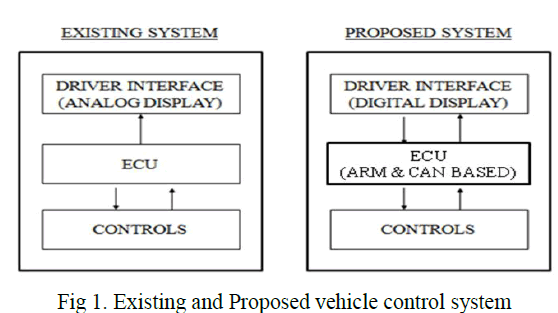 |
| Fig.1 shows the vehicle control of existing and proposed system. A vehicle was generally built with an analog drivervehicle interface for indicating various parameters of vehicle status like temperature, pressure and speed etc. To improve the driver-vehicle interface, an interactive digital system is designed. A microcontroller based data acquisition system that uses ADC to bring all control data from analog to digital format is used. Since the in-vehicle information systems are spread out all over the body of a practical vehicle, a communication module that supports to implement a one stop control of the vehicle through the master controller of the digital driving system. |
II. HARDWARE STRUCTURE |
| The hardware structure mainly integrates the CAN bus controller, ARM as the main control module, LCD display to provide Digital interface, GSM for mobile communication and other accessories. |
| A. CAN bus |
| 1. CAN Bus in an Automobile |
| CAN is a LAN (Local Area Network) controller CAN bus can transfer the serial data one by one. Fig 2 shows a typical architecture from an automotive. All participants in the CAN bus subsystems are accessible via the control unit on the CAN bus interface for sending and receiving data. CAN bus is a multi-channel transmission system. When a unit fails, it does not affect others. The data transfer rate of CAN bus in a vehicle system is different. For example, the rate of engine control system and ABS is high speed of real-time control fashion of 125Kbps to 1M bps. While, the rate of movement adjustment is low-speed with transmission rate of 10 to 125K bps. Others like multimedia systems use medium-speed rate between the previous two. This approach differentiates various channels and increases the transmission efficiency. |
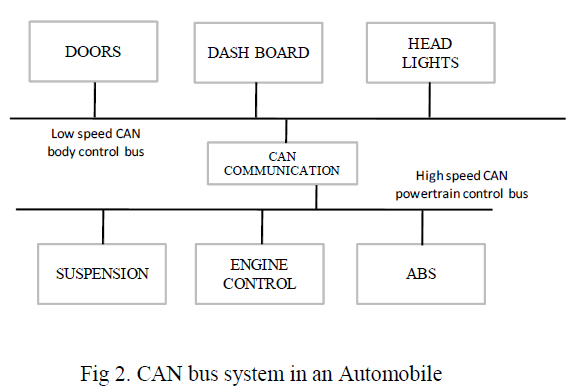 |
2. CAN Bus for vehicle drive control System |
| A typical drive system with the control unit has electronic fuel injection system, automatic transmission systems, antilock braking system (ABS), airbag systems etc. These units are the core components in a modern car system. They are sensitive for time and closed to the reliability and security of the entire system. As each control unit for real-time requirement is based on the data update rate and the control period varies, in order to meet the real-time requirements of each subsystem, it is necessary to achieve the implementation of public data sharing, such as engine speed, wheel speed, and throttle pedal location. The contents include the completion of speed measurement, fuel measurement, A/D conversion, the calculation conditions, the control actuator and a series of processes. That means the sending and receiving data in 1ms must be completed within the electrical control of gasoline in order to achieve real-time requirements. Therefore, the data exchange network must be a priority-based competitive mode, and has a very high speed communication fashion. |
3. CAN Bus for accessories control system |
| CAN bus for vehicle system is a leading control network that connects several objects. They are central controller, 4- gates controller, memory modules and other components. There are several items controlled by the CAN bus [2]. They are locker, windows, luggage locker, mirrors and interior dome light. In the case of remote control, it involves the remote control signal receiving and processing the anti-theft and warning systems. |
B. Main control module |
| 1. ARM Architecture |
| The ARM7TDMI-S is a general purpose 32-bit microprocessor, which offers high performance and very low power consumption. The ARM architecture is based on Reduced Instruction Set Computer (RISC) principles. It is the first RISC microprocessor designed for low-budget market. One of the typical products is ARM 7 family that is the most streamlined RISC. Therefore, it's relatively cheap, and the core of ARM7TDMI-S ™ is a low budget- oriented, emphasizing the control of the system. The ARM7TDMI-S processor also employs a unique architectural strategy known as Thumb, which makes it ideally suited to high-volume applications with memory restrictions. It can be used in a variety of areas, such as embedded control, multimedia, DSP and mobile applications. The LPC2119/LPC2129 are based on a 16/32 bit ARM7TDMI-S“ CPU with real-time emulation and embedded trace support, together with 128/256 kilobytes (kB) of embedded high speed bash memory. |
| 128-bit wide memory interface and a unique accelerator architecture enable 32-bit code execution at maximum clock rate. It contains a 16/32-bit ARM7TDMI-S microcontroller in a tiny LQFP64 package. With their compact 64 pin package, low power consumption, various 32-bit timers,4-channel 10-bit ADC, 2 advanced CAN channels, PWM channels, Real Time Clock and Watchdog and 46 GPIO lines with up to 9 external interrupt pins these microcontrollers are particularly suitable for automotive and industrial control applications as well as medical systems and fault-tolerant maintenance buses. It does not contain MMU (memory management unit). But because of its low price, reliability and other factors, it is widely used in various industrial controllers. |
C. Other accessories |
| IR sensor, Motor speed sensor, Alarm, Temperature sensor, Pressure sensor, Level sensor, LCD display, GSM modem. |
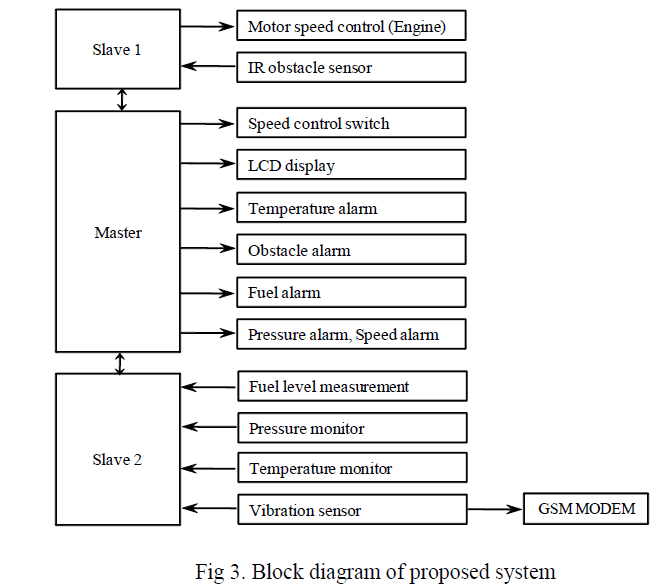 |
| Fig 3 shows the block diagram of CAN vehicle control system. It consists of one master node and two slave nodes.ARM as the master controller (Engine Control Module) which controls the vehicle status with various sensors. Two PIC ICs are used as slave nodes to receive the inputs of vehicle status. The communication between these sensors is done by using CAN controller. Slave controller receives the signals from vehicles like pressure, temperature, fuel level, and IR obstacles and GSM etc., send to master controller with high speed rate. Master controls the status of vehicle and sends the feedback to operator panel by providing digital information’s via LCD display and alarms. Here Operator interface is digital type. By this operator can easily see the signals and able to control the vehicle. IR obstacle sensor helps in identifying the obstacles presence around the vehicle. Vibration sensor detects external force (Hit by other vehicle or medium etc.,) and sends the signal to GSM. GSM will send the message to the owner of the vehicle. |
III. SOFTWARE STRUCTURE |
| The vehicle control system is programmed using the Embedded C and debugged with MPLAB X IDE. |
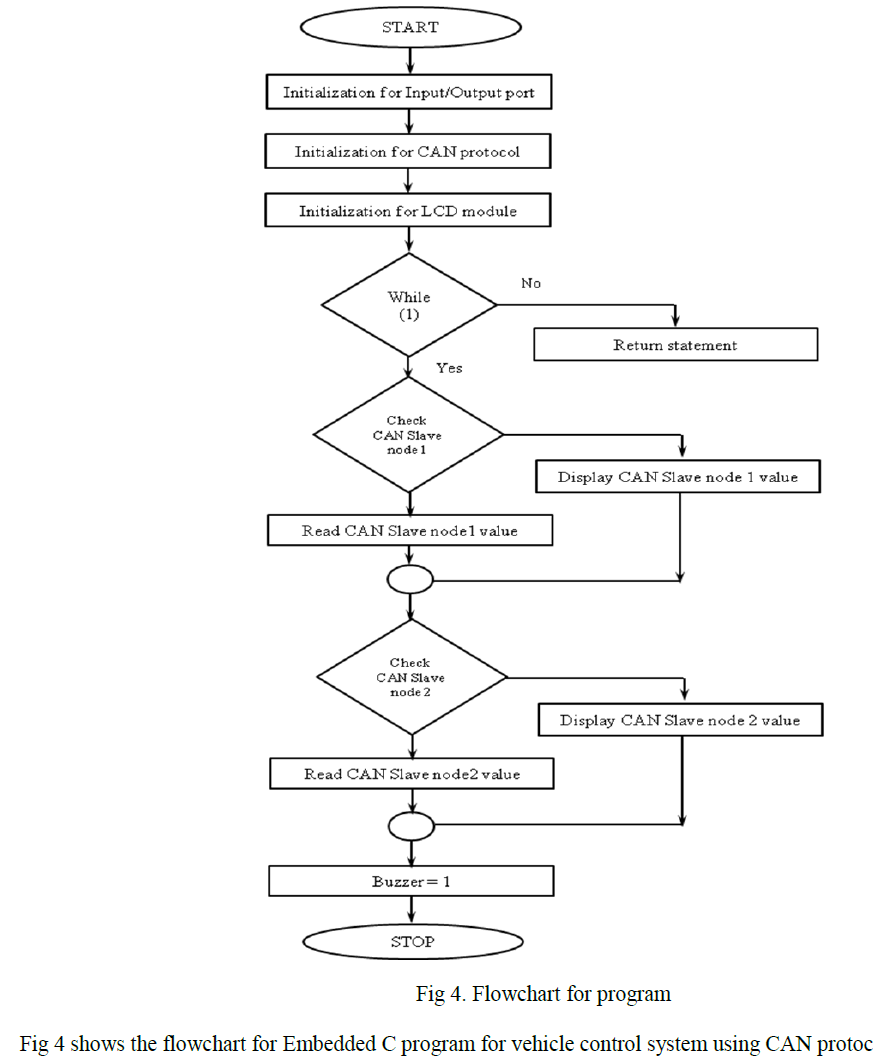 |
IV. WORKING MODEL CIRCUITS AND RESULTS |
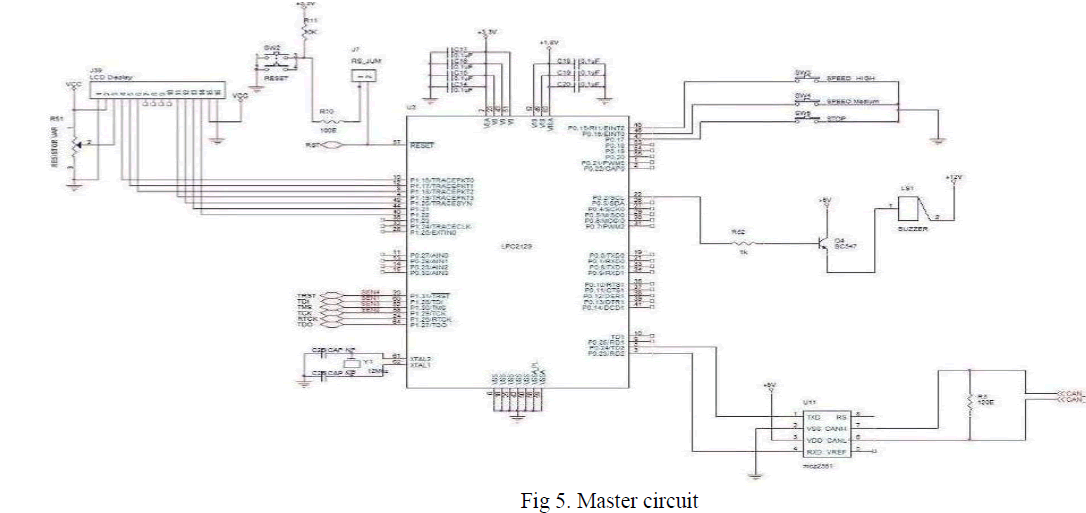 |
| Fig 5 shows the circuit diagram of master node. It consists of Arm LPC2129, Speed detection unit, LCD, Buzzer. |
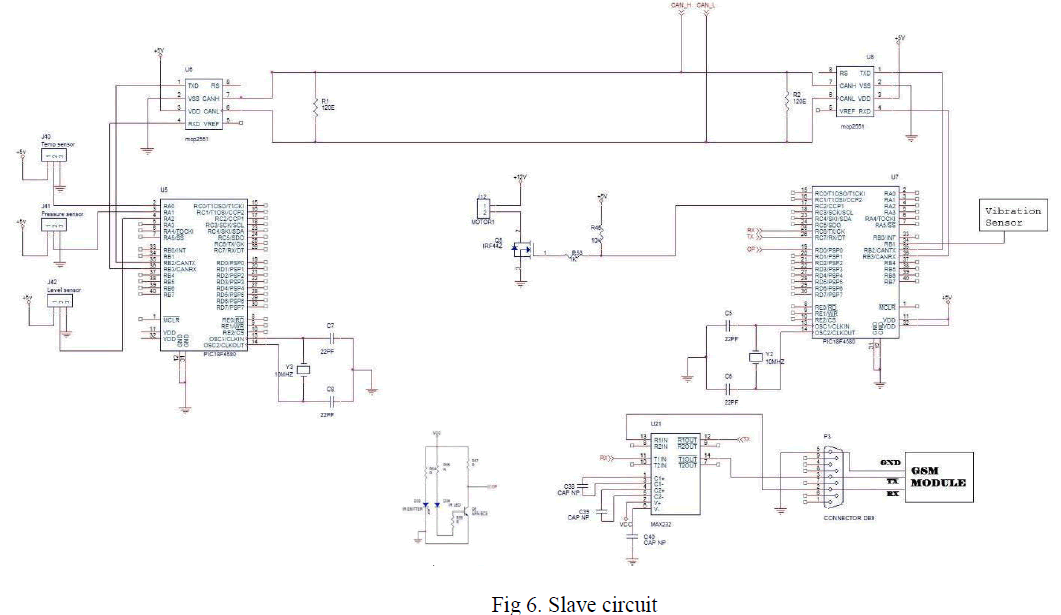 |
| Fig 6 shows the slave circuit. This unit consists 2 slave unit named as Slave 1 and Slave 2. Both slave units are PIC 18F4580 controller. Power supply for both slave units and other sensors are 5 V DC. Slave 1 unit connected with 3 sensors. Temperature sensor, Pressure sensor, Fuel level sensor. This sensor generates analog signal and send to Slave 1 controller. Slave 1 controller converting analog signal into digital signal, then sends to ARM controller through CAN MCP2551 controller. Slave 2 unit connected with following units. IR obstacle sensor, Vibration sensor, Fan (Vehicle speed), GSM modem. |
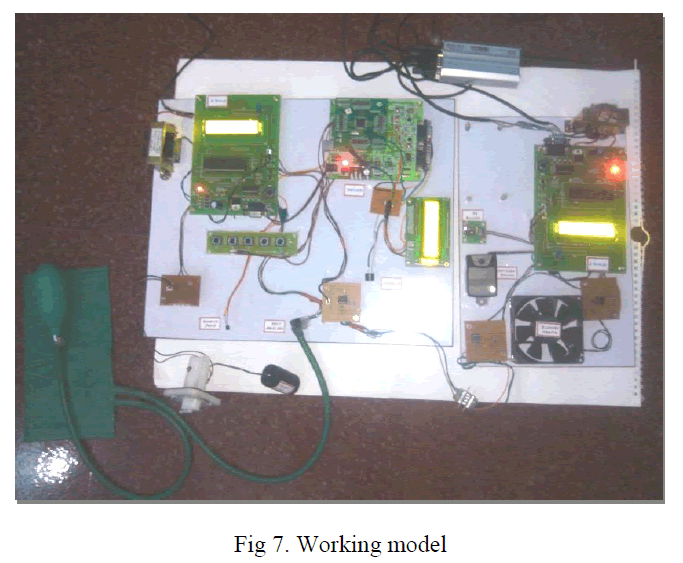 |
| Fig 7 shows the working model of vehicle control system using CAN. |
Results: |
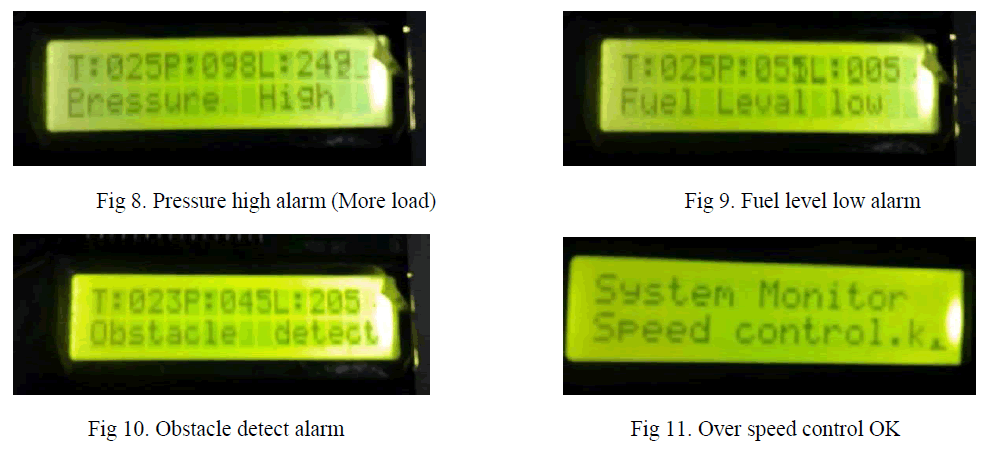 |
| The LCD provided at the driver’s panel displays the various alarms generated with different sensors. Alarm during the various cases like high pressure in tyres, Fuel level low, Obstacles around the vehicles, Over speed etc., Vibration sensor receives detects with external impact like accidents, sends the signal to GSM. GSM sends the message to vehicle owner. |
V. CONCLUSION |
| This project introduces an embedded system with a combination of CAN bus systems. Digital control of the vehicle is an important criterion of modern technology. With the rapid development of embedded technology, high-performance embedded processor is penetrated into the auto industry, which is low cost, high reliability and other features to meet the needs of the modern automobile industry. The proposed high-speed CAN bus system solves the problem of automotive system applications, also has a certain practical value and significance. With ARM as the main controller and it makes full use of the high-performance of ARM, high-speed reduction of CAN bus communication control networks and instrument control so as to achieve full sharing of data between nodes and enhance their collaborative work. This system features efficient data transfer among different nodes in the practical applications. |
References |
|